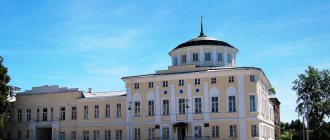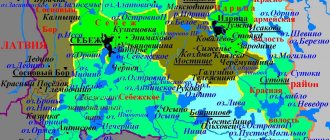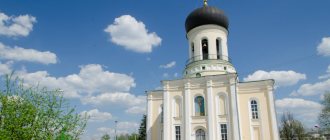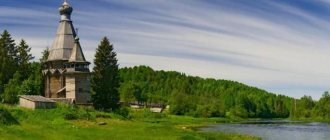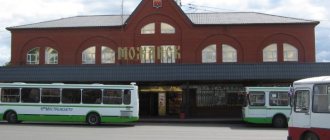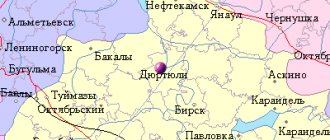Spas-Klepiki: areas, recreation, excursions, museums and churches, cuisine and restaurants, shopping and shops, attractions of Spas-Klepiki.
- Last minute tours
to Russia
On the banks of the Pra River, in the very center of Meshchera, stands Spas-Klepiki - the smallest city in the Ryazan region. It has a long history: it was first mentioned in documents in 1676 as the village of Klepikovo. The name comes from the word “klepik”, meaning a knife for cleaning fish. In the 19th century, after the opening of the Church of the Transfiguration of the Lord, the village was given a second name - Spasskoye, and the village acquired its current name.
In 1909-1912. The poet Sergei Yesenin studied at the Spas-Klepikov church-teacher school.
What to see in Spas-Klepiki in 1 day
The city of Spas-Klepiki is primarily associated with the name of the poet Sergei Yesenin and its unique nature, therefore, among its most popular attractions, in addition to the ancient St. Nicholas Church, are the poet’s school-museum and the Meshchersky National Park. If you wish, you can see all these attractions in one day.
Museum of S.A. Yesenina
- Address: st. Uritsky, 47.
In the very center of Klepiki there is a two-story brick building - an architectural monument of the late 19th century. More than a hundred years ago, there was a second-class teacher’s school here, whose most famous student was the famous poet Sergei Yesenin.
The future writer was born and raised in the village of Konstantinovo in the neighboring Rybnovsky district, but in the native places of the “singer of the village” it was difficult to obtain a profession not related to physical labor. Serezha graduated from school in his village and then went to Spas-Klepiki.
The school building was built in the second half of the 19th century, in 1895 its owner, local merchant A.A. Popov, donated the building to the Ryazan diocese. The educational institution was taught by sensitive and creative people, one of them, literature teacher E.M. Khitrov, noticed a special gift in Seryozha Yesenin and supported his poetic endeavors. Evgeny Mikhailovich became the talented boy’s first mentor in the world of literature.
In 1985, the school was turned into a museum dedicated to the main Ryazan poet. The exhibitions occupy both floors; the interior of classrooms of the late 19th and early 20th centuries, as well as student bedrooms, are recreated upstairs; the living rooms of teachers are presented below. Among the exhibits are antique desks, household items, visual aids, Yesenin's manuscripts and much more.
Meshchersky National Park
- Coordinates on the map: 55.133207, 40.166656.
A vast reserve with an area of more than 100,000 hectares occupies a significant part of the Klepikovsky district and covers a plot of land in the Ryazan district. The protected lands extend into the territory of the Vladimir region; in the neighboring region, a similar national park is called “Meshchera”. “Meshchersky” was formed in 1992; before that, tree cutting and peat extraction had been going on in the area for a long time.
The protected zone includes the famous Klepikovsky lakes, swamps, the Pra River and about 130 settlements, including the regional center. The main goal of the reserve is to preserve the unique nature of the region, while there is no strict ban on many types of activities. Local residents are engaged in agriculture, picking berries and mushrooms, which are rich in Meshchera meadows and forests. The park is popular with fishermen, hunters and ecotourists.
St. Nicholas Church
- Address: Uritsky street, 45.
The only functioning Church of the Savior-Klepikov is located near the S. Yesenin Museum. The small wooden building was built in the second half of the 19th century. Previously, there was only one parish in the settlement - the Church of the Transfiguration of the Lord, but with the development of industry, the city began to grow, believers did not have enough space in the church, and the townspeople began to think about building a new building.
The parishioners together collected the necessary amount of money and in 1859 built a small church. The main altar was consecrated in honor of St. Nicholas the Wonderworker, and the chapel was dedicated to the blessed prince Alexander Nevsky.
In 1930, the temple was closed and left empty. In the 90s, the dilapidated building was returned to the Church, but the priesthood did not have the funds to restore it, and parishioners had to be content with only the Transfiguration Church. In 2022, the Transfiguration Church burned to the ground in a terrible fire, and at the request of Bishop Dionysius, believers and clergy began to work on restoring the St. Nicholas Church.
The building was quickly cleaned up, and two days later, on the patronal feast day, a bishop's service took place there. Over time, the temple was completely renovated; at the moment it is in good condition and is open to parishioners and pilgrims every day.
Where to eat
There are several catering outlets in the city where you can eat for little money. Cafe "Old Farm" is located on the street. Prosveshcheniya, 15. According to visitors, there is a cozy atmosphere, delicious cuisine, and pleasant music. The average bill is 300 rubles.
Grill-bar "Hemingway" on the square. Lenina, 58a is popular among city residents. Delicious kebabs and vegetables are prepared here. Opening hours: from 11 a.m. to midnight.
Cultural recreation and leisure in Spas-Klepiki
In the Klepikovsky district there are several cultural and entertainment institutions where you can have fun and usefully spend time.
Forest Fortress Museum
- Address: Klepikovsky district, Lunkino village.
A few kilometers from the regional center, in the small village of Lunkino, there is a truly fabulous place - the Museum of Wooden Architecture. Much of this amazing collection is located directly in the open air. The vast territory contains dozens of funny wooden sculptures, as well as various attractions: slides, swings, carousels.
The founder of the museum, talented carver V.P. Groshev not only created most of the exhibits, but also organized a carving school for everyone who wanted to master the ancient craft. In the school building you can see amazing crafts made by Vladimir Pavlovich’s students: incredibly realistic figures of animals and people, carved paintings, dishes and even models of the ancient fortresses of Moscow and Kizhi.
In one of the rooms, the atmosphere of a pre-revolutionary peasant hut with real spinning wheels, barrels and a loom was recreated. After Groshev’s death, the museum received his name and continues the work of its creator.
Museum of Narrow Gauge Equipment
- Address: Klepikovsky district, Tuma village, Vokzalnaya street.
Another unique museum was organized at the Tumskaya station, through which until 2013 the narrow-gauge railway ran to Vladimir. The station was opened in 1899, decades later the famous writer Konstantin Paustovsky described it in his story “Meshcherskaya Side”. In 2013, management ordered the narrow-gauge railway to be dismantled, despite the fact that the tracks had the status of a historical monument.
All that remains at the station are the existing broad gauge tracks, the old water tower and the locomotive depot. The preserved transport became the basis of the Museum of Narrow Gauge Equipment. The museum's collection is not numerous, but it occupies a fairly large area, since all the exhibits in it are very large. What most impresses visitors is the TU7A diesel locomotive, carriage and snow plow. All equipment is in good condition and is open to the public.
House of Culture
- Address: st. Yesenina, 7.
Klepikovsky RDK is the cultural center of the city and region. Almost all concerts, folk festivals and creative competitions are held in a beautiful classical building in the very heart of Spas-Klepikov.
There are several groups working in the House of Culture: the “Diamond” dance group, an art studio, a film studio, VIA “Splav” and a folk theater. Leaders and their wards participate in all regional events and often perform at out-of-town festivals.
Park Hotel Festival
- Address: Klepikovsky district, Chulis village.
In the village of Chulis, next to the National Park, there is one of the best recreation centers in the Ryazan region. On its territory there is a hotel complex accommodating more than 600 guests, restaurants and a large aquatic complex with swimming pools, water slides and beauty salons.
Families with children come to the Festival; the park hotel has several playgrounds, outdoor recreation areas and even its own mini-zoo. Tourists from Ryazan, neighboring areas and the Moscow region come to the recreation center. The complex belongs to private individuals and is located in a closed area; access to all entertainment is paid.
Status
Municipal entity - Klepikovsky municipal district is an independent municipal entity within the Ryazan region.
The Klepikovsky district in its current form was formed on March 2, 1935 by the Decree of the All-Russian Central Executive Committee.
Restored within existing borders by Decree of the Presidium of the Supreme Soviet of the RSFSR dated January 12, 1965.
The charter of the municipal formation - Klepikovsky municipal district was approved by the decision of the district Council of Deputies on August 16, 1996. The new version of the Charter was approved by the Council of Deputies of the municipal formation - Klepikovsky municipal district on February 27, 2008 by decision No. 16.
Natural cities of Spas-Klepiki and its surroundings
Speaking about the sights of Spas-Klepikov, it is impossible not to mention the natural beauties of Meshchera, glorified by Russian poets and prose writers.
Lake Velikoye
- GPS coordinates: 55.222474, 40.164726.
The vast reservoir in the north of the region is the largest of the chain of beautiful Klepikovsky lakes, its length is approximately 6 kilometers. The Great is impressive in its size, but its average depth does not exceed 1.5 meters, although from time to time there are cliffs up to 5 meters deep.
The lake is so vast that it contains eight islands, not counting the small hillocks made of reeds.
On the southern, most reliable shore of the lake are the villages of Lunkino and Ushmor, the remaining shores are swampy and overgrown with tall grass, in which rare plants are found. Waterfowl nest in the thickets, and the reservoir itself is rich in fish.
Lake Beloe
- Coordinates: 55.179914, 40.168942.
The deepest of Meshchera's reservoirs is located north of Lake Velikoye. The maximum depth of the karst lake is more than 100 meters. Bely has amazingly clean, transparent water, its bottom and shores are sandy.
The reservoir is surrounded on all sides by pine trees, and the approaches to the water are overgrown with reeds. Fishermen come to the lake all year round, as it is home to crayfish and fish species such as crucian carp, roach, perch, ruff, ide, pike and tench. Divers also periodically train in Bely.
Lake Gavrinskoye
- Coordinates: 55.071597, 40.783846.
The Gavrinsky reservoir is located in the east of the region and does not belong to the Great Klepikovsky Lakes. On the western shore is the village of Resurrection, and on the eastern shore is the village of Gavrino, which gave the name to the lake. Until 1917, the reservoir was called Voskresensky after the name of the second village.
Like almost all Spas-Klepikov lakes, Gavrinskoye is of karst origin, although some villagers are convinced that it was formed relatively recently.
According to local legend, the reservoir appeared on the site of an old church that fell into the ground. Its banks are covered with herbs and flowers, including those listed in the Red Book; the most valuable of the endangered species is the hairy buttercup. In 2003, Gavrinskoye was recognized as a natural monument of regional significance.
Tract Yalmont
- Coordinates: 55.254189, 40.112922.
On the outskirts of the region, among the lakes, a mysterious, partly mystical place is lost - the Yalmont tract, surrounded by greenery. A hundred years ago, a village of the same name lived and flourished here, sparsely populated but prosperous.
During Soviet times, the village slowly died out, and nature took its toll: the area was densely overgrown with trees and bushes in a short time. Now only the ruins of the beautiful St. Nicholas Church, the old cemetery and the road remind us of human civilization.
Archeological and architectural monuments
Several particularly noteworthy ancient buildings and ancient monuments have been preserved on the territory of the national park.
Deulinsky burial ground
- Address: Meshchersky National Park.
Meshchera has been inhabited by people since ancient times; today scientists are finding more and more traces of different tribes on its territory. One of the most famous archaeological monuments discovered in the Klepikovsky district is an ancient burial ground on the right bank of the Pra River.
The burial ground was discovered by researcher V.P. Sklyarov, during excavations the scientist, together with other archaeologists, uncovered 9 burials of Ryazan-Oka Finns, adults and children. Along with the deceased, jewelry made of metal and glass and various types of weapons from darts to swords and axes were buried in the graves. Experts say that the burial ground was created in the 6th-7th centuries.
Tyukovo settlement
- Address: Meshchersky National Park.
Another archeological monument - the site of an ancient man - was found near Lake Swan in 1928. The discoverer of the site was archaeologist Otto Bader. The settlement received the name of the village of Tyukovo, which is located only a hundred meters from it. Research has shown that the first people appeared in this area during the pre-glacial period.
Experts also dug up traces of later settlements on the shore of the reservoir: fragments of ceramics, metal arrowheads and even musical instruments - flutes made from animal bones. Scientists estimate that the relics are more than 3,000 years old. Today, an information stand with a description of the ancient settlement has been installed at the excavation site.
Ruins of a railway bridge
- Coordinates: 55.124374, 40.170478.
In addition to the exhibits of the Tuma Museum, there is another legacy of the narrow-gauge road in the area - the remains of a bridge over the Pra River. The structure was built at the end of the 19th century at the same time as the tracks.
Despite the fact that the 200-meter bridge was made of wood, it could support multi-ton carriages loaded with various raw materials. Over the course of a hundred years, the building fell into disrepair and was little used, and in 2003 it completely burned down during a fire. Part of the canvas has been preserved near the river; near the very shore, surviving piles stick out of the water.
House with mezzanine
In the central part of Spas-Klepikov there are many old private houses, both brick and wooden. From a row of small one- and two-story buildings on Prosveshcheniya Street, a strikingly long house with a mezzanine stands out.
The first floor of the building is stone, the second floor and the small mezzanine are wooden. There are 25 windows on the second floor of the amazing house, and each of them is decorated with elegant carved frames. Currently, the building houses several city institutions.
Weather, best time to travel
The climate of the Ryazan region is moderate continental, not characterized by sudden changes in temperature and pressure, and is not characterized by extreme phenomena. Dry years, winter thaws and ice, frosts in early spring and late autumn, as well as thunderstorms and strong winds are common here.
current air temperature (0C), amount of precipitation (mm) and sunny days by month:
| Jan. | Feb. | March | Apr. | May | June | July | Aug. | Sep. | Oct. | Nov. | Dec. |
| -7 | -5 | -0,5 | +9,5 | +19,5 | +22 | +25,5 | +24 | +16,5 | +7,5 | +1 | -3,5 |
| 16 | 16,5 | 14,5 | 20,5 | 27 | 31 | 24 | 21 | 23 | 23,5 | 14 | 22 |
| 0 | 0 | 1 | 11 | 21 | 16 | 19 | 25 | 15 | 6 | 6 | 1 |
According to the comfort rating, calculated based on long-term weather indicators of Spas-Klepikov, the best time to travel to the city is from April to November. The comfort factor in these months exceeds 4 points. It reaches a maximum of 5 points in June and August.
Temples and churches of Klepikovsky district
Of the dozens of churches in the Klepikovsky district, only a few survived the Soviet anti-religious persecution. Most of the temples still lie in ruins, but some of the buildings were restored after the collapse of the USSR. In some villages, services are held in buildings where other institutions, such as a store or kindergarten, previously operated.
Church of the Life-Giving Trinity
- Address: Pozharnaya Square, 2A, Tuma.
A few tens of kilometers from Spas-Klepikov is the ancient village of Tuma, the largest settlement in the region, surpassing even the regional center in the number of inhabitants. The main attraction of the village is the amazing Church of the Assumption of the Blessed Virgin Mary.
The white-walled temple in the Empire style was founded in 1823 and consecrated in 1841. Initially, it had five thrones: the Holy Trinity, St. Nicholas the Wonderworker, Archangel Michael, the Protection of the Most Holy Theotokos and the Prophet Elijah. In 1863, a four-tier bell tower was added to the building.
In the 20s, the new authorities were going to close the church, but the parishioners defended their shrine. In 1930, when a commission came to the church, five hundred peasants gathered at the RAO building and demanded the return of the keys to the church. Law enforcement agencies tried to disperse the protesters, but the villagers beat the policemen and went home only after they were given the keys.
After 10 years, the temple was closed and used as a granary. For 7 years, believers sought the opening of the church, and in 1947 the administration gave in under the pressure of incessant requests and allowed the resumption of services.
Today, pilgrims from different regions of Russia come to the temple. Inside, ancient frescoes, icons and a unique two-tier iconostasis, created from white marble by Italian craftsmen, have been preserved.
Assumption Church in the village. Struzhany
- Address: Klepikovsky district, village of Struzhany.
Not far from the regional center is the ancient village of Struzhany. The pride of the village is the stunningly beautiful Church of the Assumption of the Blessed Virgin Mary. Rare tourists are surprised to see a magnificent monumental temple in such a sparsely populated region.
The spacious brick building in the Russian-Byzantine style was erected at the beginning of the 20th century. Since the 17th century, several wooden churches in honor of the Resurrection of Christ and in honor of the Dormition of the Mother of God have replaced it. The last church was sold to the village of Ershovo in 1910, shortly before the construction of a new stone structure with three chapels.
After the October Revolution, the temple was closed, but not destroyed. In 1945, the building was returned to believers. In 1996, there was a fire inside the church, but the walls and roof survived, and the structure was soon restored. Divine services are regularly held in the temple, which attract parishioners from several surrounding villages.
Kazan Church in the village. Busaevo
- Address: 175, Busaevo village.
The wooden Church of the Kazan Icon of the Mother of God decorated the village of Busaevo in 1846. In 1882, the warm Church of the Great Martyr Paraskeva Pyatnitsa stood next to it. At the beginning of the last century, a high brick bell tower was built away from the temples. Over time, the wooden buildings were supposed to be replaced by a brick church, but its construction never began due to the outbreak of the First World War.
After the events of 1917, the Kazan Church was turned into a granary, then into a club, and the Church of St. Paraskeva into a school. In 1963, during a thunderstorm, lightning struck the dome of the bell tower, and all the wooden parts of the building burned down. In 1985, a fire destroyed the school. In 2002, the surviving Kazan Church began to be restored, and 11 years later the first liturgy in the last 83 years was celebrated there.
Church of St. Alexander Nevsky
- Address: Yesenina street, Kriusha village.
The history of the cemetery church in the village of Kriusha is full of sorrows and trials. The first temple was erected in 1878 with donations from the wealthy peasant Alexander Kalabukhov. In 1912, the building was destroyed by fire, but soon a new structure rose in its place.
In 1931, the church was closed and turned into a club, and years later it was demolished to the ground. In 2008, believers erected a worship cross in memory of the destroyed shrine and chose a site for a new wooden church in honor of the same saint.
At the very moment when there was hope for the revival of the parish, a new Bela came to the village. In 2010, Kriusha suffered from large-scale fires that engulfed a large area of central Russia. The long-suffering temple burned down along with a dozen residential buildings. A year later, it was decided to restore the log house.
In 2012, a dome was erected on the finished wooden building. At the moment, parishioners and clergy continue to improve the church, rejoicing that services are finally being held outside of the open air.
Intercession Church
- Address: Egoryevskoe highway, village. Seleznevo.
In the village of Seleznevo, on the shore of a lake with the wonderful name Swan, an Old Believer church in honor of the Intercession of the Blessed Virgin Mary has been preserved. Old Believers settled in these areas in the first half of the 19th century; adherents of the old faith came to Ryazan from Bukovina at the invitation of Emperor Nicholas I.
A few years later, the community accepted the Belokrinitsky consent. In 1911, believers built a beautiful brick church with a high bell tower; Metropolitan Macarius himself came from Belaya Krinitsa to consecrate the church. Currently the temple is operational.
Hotels
There are no hotels in the small town of Spas-Klepiki. The only hotel “Va-Bank” on the street. Prosveshcheniya, 18, was recently closed. You can stop for a rest near the city.
Recreation center Polushkino
The base is located 3 km from the center of Spas-Klepikov at the address: Polushkino, 54. Guests are provided with comfortable rooms of different categories, equipped with the necessary furniture and household appliances. There is free wireless Internet on the territory of the base. Vacationers can use parking for cars, go in for water sports, and horse riding.
There is a private beach, table tennis and billiards. There is a cafe at the base where you can order food to your room, and you can prepare your own food. Cost - 2000-7000 rubles.
Parusa Park Hotel
Located on the shore of Lake Beloye, surrounded by picturesque nature. Separate houses and rooms in the hotel complex are equipped for accommodation. New modern furniture, thoughtful interiors, good equipment, as well as beautiful views of the lake from the windows distinguish the hotel rooms from other similar establishments.
The hotel has a restaurant and the beach is nearby. Room price – from 2600 rub.
Memorable sights in Spas-Klepiki
Klepikovsky monuments are few in number, most of them are dedicated to the Great Patriotic War.
Monuments to S.A. Yesenin
- Address: Prosveshcheniya Street.
Sergei Yesenin can rightfully be considered the most famous resident of Spas-Klepikov, which is why his monuments occupy the most prominent places. There are two busts of the writer in the city, one was installed in Soviet times, the other appeared relatively recently - in 2009.
A new monument, created by sculptor A. Bichukov, was installed in front of the entrance to the school-museum. The bust was solemnly unveiled on the 100th anniversary of the poet’s entry into school.
Monument to the heroes of the Second World War
- Address: Svobody Street.
The Great Patriotic War did not bypass Spas-Klepiki. The German army did not reach the city only a few tens of kilometers, when the enemy was on the outskirts of Ryazan, Klepikovsky enterprises and workers were evacuated inland. Hundreds of Klepikovites volunteered to go to the front, many never returned home.
After the war, a memorial was built on Svoboda Street in honor of the fallen fellow countrymen. In the center of the composition stands the figure of a soldier, in one hand he holds a machine gun and in the other a helmet. Attached to the pedestal on both sides of the sculpture are plaques with the names of fallen townspeople.
Avenue of Heroes
- Address: Lenin Square, 60.
A later WWII memorial is located on the central square in front of the post office and is dedicated to the Klepikovites - Heroes of the Soviet Union. From the stele standing in the middle there are rows of black monuments, on each of them the name of the hero is inscribed in gold letters and his bas-relief portrait is attached. Behind, like living monuments to the defenders, tall junipers grow.
Airplane monument
- Address: st. Svobody, 13.
Another monument to the Great Patriotic War is located next to the monument to the fallen Klepikovites and is a Czechoslovakian L-29 training aircraft. At one time, this model was used to train pilots all over the world. The car was placed on a pedestal in 1995. The opening of the monument was timed to coincide with the 50th anniversary of the Great Victory.
Girl with cubs
- Address: square on Yesenina.
A sweet and kind sculpture in the center of the town is a legacy of the Soviet era. A teenage girl, dressed in a school uniform, bottle feeds two small bear cubs. Funny animals stood on their hind legs and greedily stretched their muzzles towards the milk. Local residents take care of the beautiful monument; the sculpture is repaired from time to time and covered with white paint.
Don’t miss the materials in the topic of the post, about the sights of Skopin, Kasimov, Gus-Zhelezny
The town of Spas-Klepiki is certainly full of pleasant surprises. Ancient and extremely colorful, it proves that in any corner of Russia, even in the most remote provinces, you can find something beautiful and unique.
Story
In the 17th century Two important trade routes passed through Spas-Klepiki: Ryazan - Vladimir and Yegoryevsk - Kasimov. Thanks to this, the village turned into a major center of transit trade and wealthy merchants became interested in it. In the center of the settlement, they built their houses, forming a quadrangular square, from which radiated streets with simpler houses, where artisans, handicraftsmen, and minor officials lived. By 1905, Spas-Klepiki had become a fairly large village with several dozen shops, a post and telegraph office, two churches, a zemstvo hospital, a pharmacy, a hotel, three schools, a railway station and even a cinema. There were tanneries and soap factories here, as well as a dozen cotton factories. In 1920, the village received city status.
